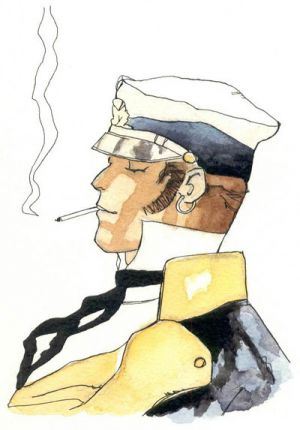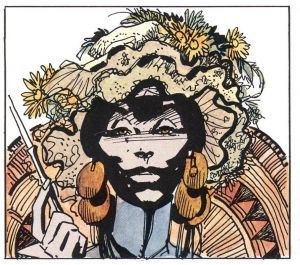Queer Voices in Hugo Pratt’s Corto Maltese
By Hervé St-Louis
August 13, 2014 - 11:43
 |
From a cultural studies’ perspective many marginalized comic book readers seek fair representation. Non-white, non cis-gendered, non-male, and non-straight fans criticize poor inclusion of others in comics. Publishers try to respond to these needs in different ways. One trick by Marvel and DC Comics is to transform an established comic book character into a female, a gay, or a non white-person. Nick Fury of S.H.I.E.L.D. was white in the past. David Hasselhoff was the first actor to play him in a non-memorable television movie. When Marvel Comics launched the Avengers as The Ultimates in 2002 Nick Fury was black and looked like Samuel L. Jackson. Later, Jackson played Nick Fury in Marvel’s cinematic universe. Nick Fury's black depiction is the main one in popular culture.
Nick Fury is an exception. Changing the creed of a comic book character is often unsuccessful. Another trick publishers use to diversify their comics is by creating diverse legacy characters. Legacy characters are new versions of existing ones. Diverse legacy characters allow originals to remain. One version of Spider-man in comic books is now a black teen. The man holding the title of Captain America is currently African-American Sam Wilson. Both changes are controversial. Changing the creed of comic book characters creates cultural wars within comic books communities. On one side are readers with genuine interests in more representation of diversity in comics. On the other side stand creators and old time readers of dominant groups who resist and often oppose change.
Italian cartoonist Hugo Pratt used a different approach to representing the other in his work. His most famous fictional character, Corto Maltese is of mixed ethnicity. A British subject, he is not a representative from a mainstream cultural group. Corto Maltese’s mother was a Gypsy prostitute in Malta. His father is an unnamed British sailor. Corto Maltese is not ashamed of calling himself a bastard. He grew up in a Jewish ghetto in Venice. Just like his creator, Corto Maltese has travelled the world and met people of all creeds in his journeys.
Scholar Teresa de Lauretis proposed queer theory as an alternative to study gay and lesbian phenomena. It does not focus on deviance and the preference of queer individuals. Instead, queer theory focuses on the resistance to cultural homogenization. Queer theory celebrates the resistance of assimilation to a dominant group. It is different than cultural studies. Cultural studies borrow Marxist critical methods to criticize non-economic cultural hegemony. Queer theory is a useful framework to study marginalized groups refusing to integrate within the mainstream.
In Corto Maltese there is little normative culture. His adventures occur throughout the world from the global South to the Siberian plains. In his travels, Corto Maltese meets characters of different creed. Some are his enemies. Some are friends. Some are potential lovers. In Pratt’s work, each character whether an Amazonian native rebel or a German submarine captain has an equal voice. Cranio, a Melanesian pirate works under whites. Yet he is not naïve about the role his people play in World War One politics. Cranio dresses as a European but keeps his facial make up and some of his traditional attire. While villain Rasputin does not trust him, he knows that Cranio is the only one who can lead the other Melanesians on his pirate ship.
 |
Mutual respect of the other and the queer is one of the main qualities of Corto Maltese. Russian-born Rasputin is Corto Maltese’s doppelganger. He appears in many of his stories, threatening to kill him. They are like brothers, arch-enemies, and best friends. This old bickering couple provides much comedy. Rasputin has no honour and is anti-social. He functions on the margins of society, much like Corto Maltese. He is an evil reflection of the hero. There is mutual respect between the two of them, even though Rasputin has few redeeming values.
What is peculiar and great about Pratt’s Corto Maltese is how the queerest of characters coexist in one world. Gentile heirs board ships with escaped felons. Pratt does not need to force any integration of the queer within the hegemony. It just is. Bouche Dorée is Corto Maltese greatest love even if she is an older black woman. Comic book readers who dislike this cannot claim to like Corto Maltese. There is no editorial change to comic book characters whose merits fans debate with acrimony. In Corto Maltese every character is queer and free of judgment based on their creed. Each has an opportunity to say something profound that others can hear.
Works Cited
Jagose, Annamarie. "Feminism's Queer Theory." Feminism & Psychology 19, no. 2 (2009): 154-174.
Related Articles:
Corto Maltese Océan noir
Corto Maltese: Fable of Venice comics review
Queer Voices in Hugo Pratt’s Corto Maltese
Can IDW Deliver Corto Maltese Properly?
Corto Maltese : Toujours un peu plus loin
